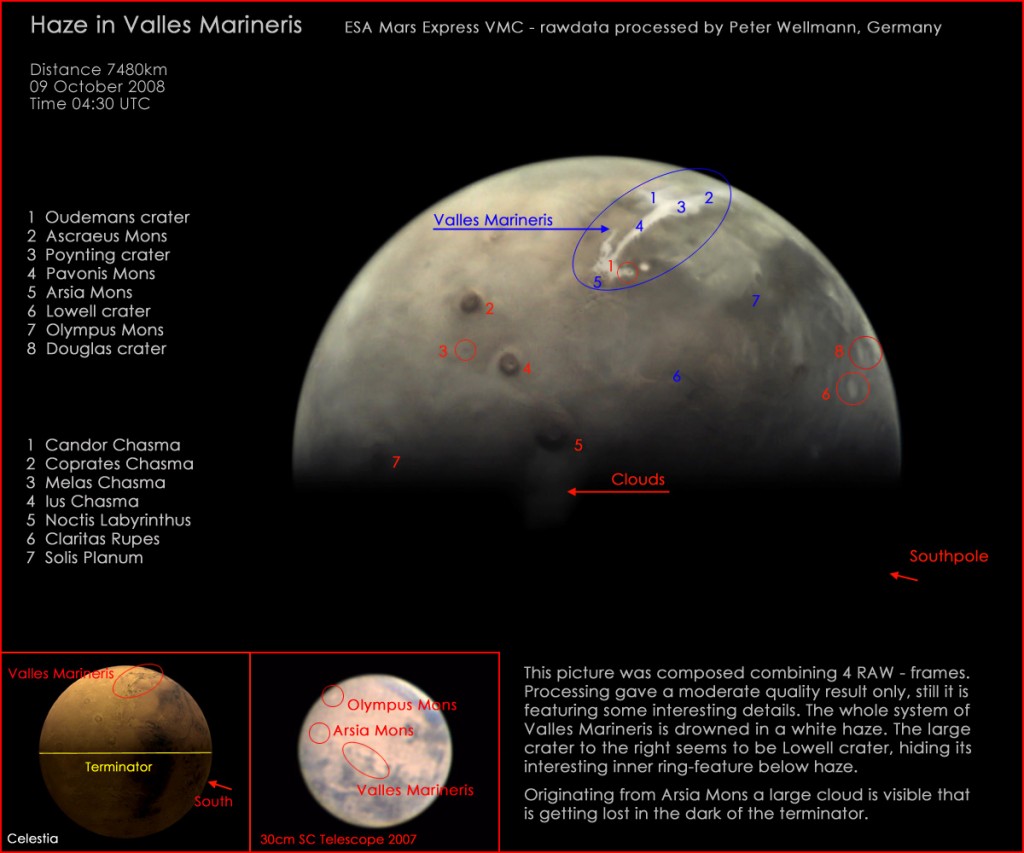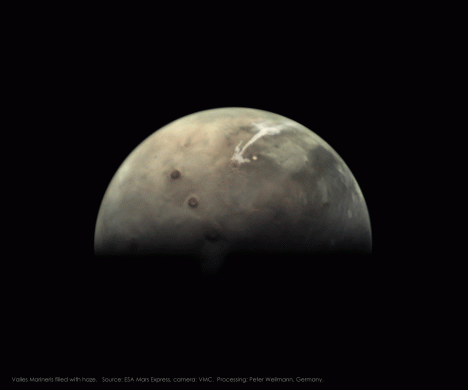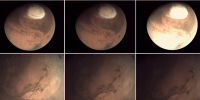We have an excellent submission to share with you as today’s Friday treat: a poster project entitled ‘Haze in Valles Marineris by Peter Wellmann’.
Peter has created a beautiful enhanced image and a poster highlighting atmospheric haze high above Valles Marineris; these are based on four VMC images acquired on 9 October 2008 (proving the point that archived data can have value years after it was collected) when Mars Express was orbiting about 7500 km above the surface.
Peter’s first image shows a beautiful, long wispy streak of haze running over the entire Valles Marineris surface system – at more than 4000 km long, 200 km wide and 7 km deep, the Valles Marineris rift system is the largest-known canyon in the Solar System (and is much larger than North America’s puny Grand Canyon). His poster includes many additional details of surface geography and clouds.
We were really impressed with the analysis that Peter did prior to starting image enhancement work – which was a challenge due to the considerable amount of movement by Mars Express during the 3.5-minute slot in which the four raw images were acquired. This work follows on Peter’s earlier submission, North polar cap – posters by Peter Wellmann, posted on 18 August.
Thanks, Peter, for an excellent submission! (Click on ‘Full story’ to access more details and the full-size versions of the images). — Daniel Scuka
The original Mars Webcam images (Nos. 3, 4, 5 and 7) can be found in the 9.10.2008 set here.
First, here are Peter’s two images (his explanatory text is below).
Peter writes:
“The picture of Valles Marineris: About 7500 km out from Mars, Mars Express VMC shot a sequence of pictures showing interesting details. The whole system of Valles Marineris is drowned in a white haze. The large crater to the right seems to be Lowell crater, hiding its interesting inner ring-feature below haze. Originating from Arsia Mons a large cloud is visible that is getting lost in the dark of the terminator.
Viewing the raw-material from 2008/10/09, we had the idea that the hazy patch seen at the terminator in the region of Arsia Mons could be some kind of reflection, but studying the other frames of the sequence showed that this rather is a true structure on Mars. Reaching into the dark of the terminator, it must be high above the ground – probably a large cloud originating near Arsia Mons.
For processing it was decided to use four raw frames to reduce noise, taking into account that this would not deliver a perfect result due to the considerable movement of Mars Express during the 3.5 minutes slot the pictures were taken.
• 08-283_04.27.15_VMC_Img_No_3 (‘red’ image)
• 08-283_04.28.08_VMC_Img_No_4 (‘blue’ image)
• 08-283_04.29.01_VMC_Img_No_5 (‘blue’ image)
• 08-283_04.30.47_VMC_Img_No_7 (‘red’ image)
Using vmc_flat.raw flatfield and vmc2rgb.exe tools, the pictures were converted from .raw to .png files. The VMC flatfield works fine – at the time being there is only one larger defect that is not corrected sufficiently. After resizing to 150 percent, the two red and blue pictures were stacked. After cutting out the overexposed part with a feathered selection, the blue result was stacked to the red result with 60% transparency. As expected, the rapid movement of Mars Express became a problem, we could not find a perfect fit for the stacked frames. Having no special (and expensive) software for this purpose, we adjusted this sufficiently for a medium quality result only. The final picture was sharpened with a Mexican Hat filter, then high frequency noise was reduced with the software Neat Image, sacrificing some sharpness again.
Finally, Photoshop was used to give the picture the ‘final touch” by carefully removing known artifacts of VMC, adjusting levels and colour saturation and cleaning the dark background of the picture. When adjusting levels and colour, a mask for white with a tolerance of 60 and feathered edges of 3 pixels was used to emphasize the hazy area of Valles Marineris.”
Thanks Peter!





Discussion: no comments